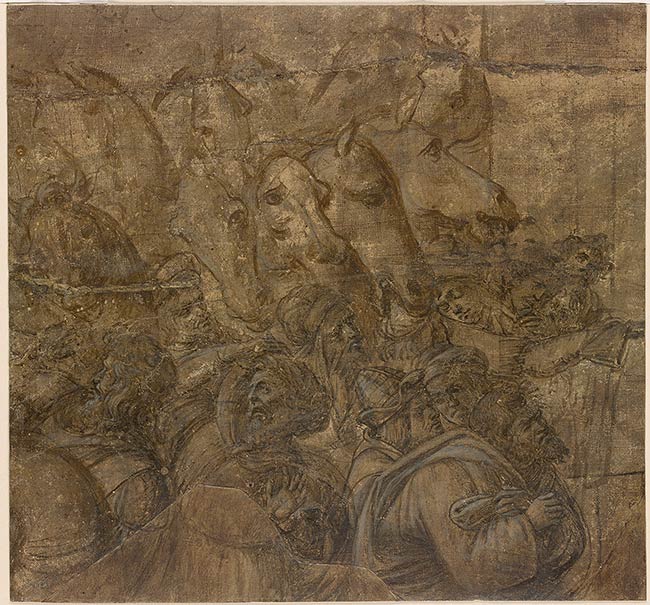

One of the preeminent painters of the early Renaissance, Botticelli enjoyed the patronage of the Medici in Florence but also worked in Rome in the early 1480s on the decoration of the walls of the Sistine Chapel. His drawings are relatively rare, and the present example, executed with a brush and brown oil on fine linen, is more akin to a fragment of a grisaille painting than a true drawing. Together with two sections in the Fitzwilliam Museum, Cambridge (inv. 910 and inv. 2888),1 it once formed part of a now-destroyed composition of the Adoration of the Magi. As reconstructed from these fragments, the complete grisaille would have included the horses and adoring onlookers from the magi’s retinue at left (the Morgan drawing), a central section with the seated Virgin and child, St. Joseph, and a kneeling magus (one of the Fitzwilliam pieces), and additional members of the kings’ retinue at right (the other Fitzwilliam fragment).
The reconstructed image corresponds closely to Botticelli’s unfinished and repainted Adoration of the Magi in the Uffizi,2 which is generally dated late in the artist’s career (around 1500–1505) and with which the drawing is probably contemporary. Superimposing the two compositions reveals that elements such as individual figures of the fragments closely match the Uffizi painting, although the fragments differ in scale and proportion from the latter and therefore the two cannot be made to align completely.3 In both, Botticelli concentrated on the passionate devotion of his figures, revealed here in their pressing, gesturing, and crowding, all indicative of their eagerness to be close to the infant Christ. Overall, the composition and monochrome painting technique seen in the three fragments reveal a clear aware ness of Leonardo’s earlier, unfinished Adoration of the Magi commissioned in 1481 now at the Uffizi.
Despite its apparent link to the Botticelli in the Uffi the purpose of the original dismembered canvas remains unclear. It may have been intended simply as a monochromatic painting or, more likely, as a large-scale modello, or finished study, that served as a guide to laying out the composition and establishing light values for an Adoration of the Magi, among the most frequently depicted subjects of the period. Because of their high degree of finish and extensive modeling, it is less likely that the fragments were part of the underdrawing of a painting that never went beyond the preparatory chiaroscuro stage. Early in the last century, Herbert Horne suggested that the fragments were related to a large fresco of the Adoration that Botticelli painted in the Palazzo Vecchio, Florence, and that was destroyed to make way for Giorgio Vasari’s extensive renovations—a proposal impossible to confirm since no visual record of the earlier fresco survives.4
The three linen fragments probably remained together, passing through the Ottley, Lawrence, and Russell collections under the name of the artist’s master, Filippo Lippi, until they were dispersed at auction in 1884.5 In 1893 Hermann Ulmann attributed the entire group to Botticelli,6 a suggestion that has become universally accepted.7
—REP
Footnotes:
- Berlin 2000, 372–74, appendix 24–25; Scrase 2011, 121–23, nos. 94–95.
- See Mandel 1985, no. 153.
- According to a superimposition constructed by Robert Brennan in early 2016.
- Horne 1903. The fresco is mentioned in the Codex Magliabechiano, Biblioteca Nazionale, Florence, compiled in the 1540s: “Et e di sua mano nel Palazo de Signorj sopra la schala che va alla catena l’istoria de 3 magi”; cited in Horne 1980, 344.
- The reference to the exact number of fragments is somewhat confusing, since the fragment at the Fitzwilliam Museum, Cambridge, inv. 2888, had at one point been cut in two but was reunited in 1909–10.
- Ulmann 1893, 147.
- Early in the twentieth century, only Herbert Horne considered them a product of the artist’s workshop; Horne 1903, 1908.
Watermark: unknown because of linen.
Formerly attributed to Fra Filippo Lippi.
Inscribed on verso of lining, in graphite, "1554".
Ottley, William Young, 1771-1836, former owner.
Lawrence, Thomas, Sir, 1769-1830, former owner.
Russell, William, 1800-1884, former owner.
Salting, George, 1835-1909, former owner.
Murray, Charles Fairfax, 1849-1919, former owner.
Morgan, J. Pierpont (John Pierpont), 1837-1913, former owner.
Morgan, J. P. (John Pierpont), 1867-1943, former owner.
Rhoda Eitel-Porter and and John Marciari, Italian Renaissance Drawings at the Morgan Library & Museum, New York, 2019, no. 25.
Selected references: Ulmann 1893, 147; Horne 1903, 69-70; Fairfax Murray 1905-12, 1: no. 5; Horne 1908, 47; Horne 1909, 40; Yashiro 1925, 21, 241; Toronto 1926, no. 28; van Marle 1931, 23, 122; Berenson 1938, 1:333-34, 2: no. 569a; Bertini 1953, 10; Ragghianti 1954, 117-18; Cambridge 1960, under no. 19; Berenson 1961, 105, 108; Pouncey 1964, 283; New York 1965-66, no. 11; Salvini 1965-66, 4: no. 71b-73; Vitzthum 1966, 109; Lightbown 1978, 2:112-13; Horne 1980, 47; New York 1981, no. 5; Mandel 1985, no. 154; Lightbown 1989, 300, 332; Thiébaut 1991, 150-51; Florence 1992, no. 14.10, and under no. 14.12; Cropper 1994, 274-75; Berlin 2000, 372; Cecchi 2005, 360, 367; New York 2006, no. 4; Scrase 2011, under no. 94.
Collection J. Pierpont Morgan : Drawings by the Old Masters Formed by C. Fairfax Murray. London : Privately printed, 1905-1912, I, 5, repr.
Stampfle, Felice, and Jacob Bean. Drawings from New York collections. I: The Italian Renaissance. New York : Metropolitan Museum of Art : Pierpont Morgan Library, 1965, p. 24-5, no. 11, repr.
European drawings, 1375-1825 / catalogue compiled by Cara D. Denison & Helen B. Mules ; with the assistance of Jane V. Shoaf. New York : Pierpont Morgan Library ; Oxford : Oxford University Press, 1981, p. 33-4, no. 5.
From Leonardo to Pollock: Master drawings from the Morgan Library. New York: Morgan Library, 2006, cat. no. 4, p. 10-11.
